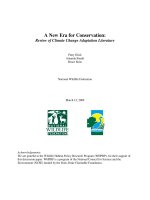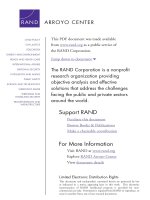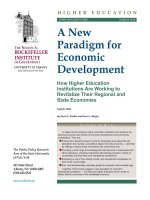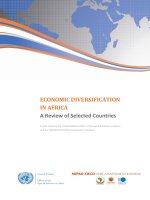Food and health in Europe: a new basis for action pdf
Bạn đang xem bản rút gọn của tài liệu. Xem và tải ngay bản đầy đủ của tài liệu tại đây (714.21 KB, 38 trang )
Food and health
in Europe
Summary
The World Health Organization was established in 1948 as a specialized
agency of the United Nations serving as the directing and coordinating
authority for international health matters and public health. One of WHO’s
constitutional functions is to provide objective and reliable information and
advice in the field of human health, a responsibility that it fulfils in part
through its publications programmes. Through its publications, the
Organization seeks to support national health strategies and address the
most pressing public health concerns.
The WHO Regional Office for Europe is one of six regional offices
throughout the world, each with its own programme geared to the particular
health problems of the countries it serves. The European Region embraces
some 870 million people living in an area stretching from Greenland in the
north and the Mediterranean in the south to the Pacific shores of the Russian
Federation. The European programme of WHO therefore concentrates both
on the problems associated with industrial and post-industrial society and
on those faced by the emerging democracies of central and eastern Europe
and the former USSR.
To ensure the widest possible availability of authoritative information
and guidance on health matters, WHO secures broad international
distribution of its publications and encourages their translation and
adaptation. By helping to promote and protect health and prevent and
control disease, WHO’s books contribute to achieving the Organization’s
principal objective – the attainment by all people of the highest possible
level of health.
Food and health in Europe:
a new basis for action
Summary
WHO Library Cataloguing in Publication Data
Food and health in Europe : a new basis for action ; summary
1.Nutrition 2.Food supply 3.Food contamination – prevention and control
4.Nutritional requirements 5.Nutrition policy 6.Intersectoral cooperation
7.Sustainability 8.Europe
ISBN 92 890 1364 8 (NLM Classification: WA 695)
Text editing: Mary Stewart Burgher
Food and health
in Europe:
a new basis
for action
Summary
ISBN 92 890 1364 8
The Regional Office for Europe of the World Health Organization welcomes
requests for permission to reproduce or translate its publications, in part or
in full. Applications and enquiries should be addressed to the Publications
unit, WHO Regional Office for Europe, Scherfigsvej 8, DK-2100
Copenhagen Ø, Denmark, which will be glad to provide the latest information
on any changes made to the text, plans for new editions, and reprints and
translations already available.
©World Health Organization 2002
Publications of the World Health Organization enjoy copyright protection
in accordance with the provisions of Protocol 2 of the Universal Copyright
Convention. All rights reserved.
The designations employed and the presentation of the material in this
publication do not imply the expression of any opinion whatsoever on the
part of the Secretariat of the World Health Organization concerning the legal
status of any country, territory, city or area or of its authorities, or concerning
the delimitation of its frontiers or boundaries. The names of countries or
areas used in this publication are those that obtained at the time the original
language edition of the book was prepared.
The mention of specific companies or of certain manufacturers’ products
does not imply that they are endorsed or recommended by the World Health
Organization in preference to others of a similar nature that are not mentioned.
Errors and omissions excepted, the names of proprietary products are
distinguished by initial capital letters.
The views expressed in this publication are those of the contributors and
do not necessarily represent the decisions or the stated policy of the World
Health Organization.
P
RINTED IN DENMARK
Contents
Abbreviations vi
Foreword vii
Introduction 1
WHO’s commitment to food security, food safety and nutrition 1
1. The burden of disease and the importance of food 3
Nutrition’s effect on the burden of disease 4
Increasing concern about food safety 6
Food and nutrition insecurity 7
2. Policy coordination 11
Multisectoral policies for nutrition and food security 11
Multisectoral policies for food safety 15
3. Policies for the 21
st
century 19
Sustainable and healthy food production 19
Action to protect health 20
WHO’s commitment 22
4. The way forward 23
5. References 25
v
Abbreviations
BMI body mass index
BSE bovine spongiform encephalopathy
CCEE countries of central and eastern Europe
CHD coronary heart disease
CVD cardiovascular diseases
DALYs disability-adjusted life-years
EFSA European Food Safety Authority
FAO Food and Agriculture Organization
of the United Nations
GEMS/Food WHO Global Environment Monitoring System –
Food Contamination Monitoring and
Assessment Programme
HDL cholesterol high-density lipoprotein cholesterol
LDL cholesterol low-density lipoprotein cholesterol
NIS newly independent states
vCJD variant Creutzfeldt-Jakob disease
vi
Foreword
T
he WHO Regional Office for Europe encourages and supports countries
in developing and implementing their food and nutrition action
plans. Two major publications provide an important part of this support. Each
covers the same information, but tailors it to meet the needs of very different
audiences.
The first is a large forthcoming book that provides in-depth analysis of nutritional
health, foodborne disease, and concerns about the supply and security of food in
Europe. Written and reviewed by great numbers of experts from all over the European
Region, the book provides the scientific evidence for national action plans and
WHO’s First Food and Nutrition Action Plan for the European Region. It provides
information for the use of health professionals, in order to strengthen their capacity
to improve public health. The second publication is this booklet, a brief summary of
the much larger book that is aimed primarily at policy-makers.
This summary follows the structure of the book, but addresses the key actions
that need to be implemented by decision- and policy-makers. Like the larger book,
it presents the contribution of food and nutrition to the burden of ill health, threats
to the quality and safety of food and the problems of ensuring optimum supplies of
high-quality, nutritious food to all Europeans. Having summarized the evidence
and shown the need for action, it focuses on the options for policy, describing the
steps for decision-makers to take.
The challenge for policy-makers is that policies in many sectors – ranging from
agriculture, food processing, manufacturing and retailing, to catering and
advertising – shape the availability, accessibility and eventual consumption of
food. This is why policies need to be coordinated so that public health is given due
priority in the making of food policies by non-health sectors. Changes in eating
patterns that harm public health are not inevitable, but policy-makers need
information and data so that they can make informed decisions to prevent harm.
Nationally collected data can be compared with international norms and standards
to ensure that public health is at the centre of policy decisions. Issues such as ensuring
Europe has a sustainable and healthy food supply, reducing levels of obesity and
physical inactivity and protecting against foodborne diseases require urgent attention
over the next few years. One of the most important steps is the coordination of
policy-making to ensure that the food policies of all sectors give the proper priority to
public health.
vii
Both the larger book and this summary highlight the urgent need for integrated,
multisectoral food and nutrition policies to encourage the sustainable production of
food, its safety and the provision of food of high nutritional quality for all.
Marc Danzon
WHO Regional Director for Europe
viii Food and health in Europe
Introduction
T
he International Conference on Nutrition in 1992 and the world food
summits in 1996 and 2002 stressed that access to a safe and healthy
variety of food is a fundamental human right. An optimum supply of safe and
nutritious food is a prerequisite for the protection and promotion of health.
Despite the commitments and efforts made at the national and
international levels, policies are still needed to reduce the burden of food-
related ill health and its cost to society and health services in the European
Region. The First Action Plan for Food and Nutrition Policy, WHO European
Region 2000–2005 (1) stresses the need for decision-makers to develop
policies on food and nutrition that protect and promote health and reduce
the burden of food-related disease, while contributing to socioeconomic
development and a sustainable environment in the European Region.
This summary is based on a larger forthcoming publication that discusses
different components of food and nutrition policies and the evidence to
support them. It describes the rising health costs of failures in food supply,
shows the need for action and describes the steps for decision-makers to take.
The larger book and this summary highlight the urgent need for integrated,
multisectoral food and nutrition policies to encourage the sustainable production
of food, its safety and the provision of food of high nutritional quality for all.
WHO’s commitment to food security, food safety
and nutrition
Recognizing the importance of food in the maintenance of health, WHO’s
governing body, the World Health Assembly, has adopted several resolutions
supporting national and international action to strengthen food policies.
• Resolution WHA 53.15 (2000) urged Member States to develop policies
on food safety that were integrated with those on public health and
nutrition, and committed WHO to increasing its surveillance activities,
to developing collaborative scientific action, to supporting the inclusion
of health considerations in international food trading and to supporting
capacity building. (In 2002, WHO issued a global strategy for food safety
that outlines the action needed to reduce foodborne illness.)
1
2 Food and health in Europe
• Resolutions WHA 54.2 (2001) and WHA 55.25 (2002) on infant and
young child nutrition urged Member States to encourage breastfeeding
through, for example, parent- and baby-friendly hospital environments,
and to strengthen their controls on the marketing of breast-milk
substitutes, with the support of WHO. (In 2002, WHO issued a global
strategy for infant and young child feeding that outlines the action necessary
to promote the youngest children’s health.)
• Resolution WHA 55.11 on health and sustainable development (2002)
requested WHO to help countries to frame policies and implement national
plans that promote sustainable and health promoting patterns of con-
sumption.
• Resolution WHA 55.23 (2002) urged Member States to develop national
plans of action on nutrition and physical activity, with strategies on diet
that involve all sectors, including civil society and the food industry, and
committed WHO to developing a global strategy on diet, physical activity
and health within its strategy for noncommunicable disease prevention
and control.
In Europe, the fiftieth session of the WHO Regional Committee for
Europe addressed food supplies, food safety and nutrition in 2000. Regional
Committee resolution EUR/RC50/R8 endorsed the five-year Action Plan to
develop integrated policies on food and nutrition. This book is part of the
continuing programme in this field.
At its fifty-first session in 2001, the Regional Committee considered
inequalities, including the issue of food poverty (document EUR/RC51/8).
Regional Committee resolution EUR/RC51/R6 committed the WHO
Regional Office for Europe to mobilizing resources for activities on poverty
and health within a regional framework.
1. The burden of disease and
the importance of food
F
ood plays a hugely important role in causing and preventing many diseases.
Eating an inadequate range of foods can lead to deficiency diseases, and
contaminated food can cause foodborne diseases. The economic consequences
of poor nourishment include lower productivity, family distress and con-
siderable costs to national health services.
Discordant agricultural, industrial and food policies can harm health, the
environment and the economy, but harmful effects can be reduced and
health promoted if all sectors are aware of the policy options. National
policies on food and nutrition should address three overlapping areas:
nutrition, food safety and a sustainable food supply (food security). The First
Action Plan for Food and Nutrition Policy (1) calls for interrelated strategies
on all three (Fig. 1).
Food safety
Nutrition
Sustainable
food supply
F
o
o
d
a
n
d
n
u
t
r
i
t
i
o
n
p
o
l
i
c
y
H
E
A
L
T
H
2
1
A
g
e
n
d
a
2
1
Source: The First Action Plan for Food and Nutrition Policy, WHO European Region
2000–2005 (1).
Fig. 1. A comprehensive policy on food and nutrition
3
4 Food and health in Europe
A nutrition strategy aims to promote health and prevent nutrition
deficiencies and chronic diseases, such as cardiovascular diseases and cancer.
It works to ensure optimal health, especially in low-income groups and
during critical periods throughout life, such as infancy, childhood, pregnancy
and lactation, and older age.
A strategy on food safety highlights the need to prevent contamination,
both chemical and biological, at all stages of the food chain. The potential
impact of unsafe food on human health is of great concern, and new food
safety systems that take a farm-to-fork perspective are being developed.
A food security strategy should ensure that enough food of good quality is
available, while helping to stimulate rural economies and to promote the
social and environmental aspects of sustainable development.
Nutrition’s effect on the burden of disease
Poor nutrition makes an important contribution to the burden of disease in
Europe. A diet high in saturated fat and energy-dense foods (those with high
fat and/or sugar content), and low in fruit and vegetables – along with a
sedentary lifestyle and smoking – is the major cause of cardiovascular diseases
(CVD), cancer and obesity. CVD and cancer are the top two causes of death
in the WHO European Region.
CVD, for example, cause over 4 million deaths per year in Europe. Coronary
heart disease (CHD) is the most common cause of premature death,
accounting for nearly 90 000 deaths per year: 16% of all premature deaths in
men and 12% in women. Moreover, in the countries of central and eastern
Europe (CCEE) and the newly independent states (NIS), CHD mortality is
almost double that in the European Union (EU) and is still rising in many
countries. The picture for stroke is the same. In western Europe, deaths from
CVD are declining, but prevalence appears to be increasing. The risk of CVD
increases with age, and improved survival rates mean that, with an ageing
population, a greater number of Europeans live with impaired cardiovascular
health.
Around one third of CVD cases are related to eating a poor diet (2). Better
diets could prevent around 30–40% of cancer cases (3). Up to 20–30% of
adults are obese,
1
and obesity shows escalating rates in children, increasing
their future risk of CVD (4). Further, preliminary analyses suggest that poor
nutrition accounts for 4.6% of the total disability-adjusted life-years lost in
the EU, with obesity and physical inactivity accounting for an additional
3.7% and 1.4%, respectively (5).
1
Obesity is defined as a body mass index (BMI) of 30 or more; BMI is determined by
dividing one’s weight in kg by one’s height in m
2
.
The burden of disease and the importance of food 5
Fig. 2 shows the role of poor nutrition in the major causes of disability and
early death in the WHO European Region. In 2000, 136 million years of
healthy life were lost; major nutritional risk factors caused the loss of over
56 million, and nutritional factors played a role in the loss of a further
52 million (6). Deficiencies in such nutrients as iodine and iron are still
prevalent in the Region. Iodine deficiency affects around 16% of the European
population and is a major cause of preventable mental retardation. Iron-
deficiency anaemia affects millions of people. It impairs cognitive development
in children and increases the risks of illness and death to pregnant women. As
discussed below, low rates of breastfeeding and poor feeding practices
Fig. 2. Lost years of healthy life in the European Region, 2000
Source: adapted from The world health report 2000. Health systems: improving per-
formance (6).
Unintentional
injury
(45.9%)
Intentional
injury
(21.9%)
Genitourinary
diseases
(5%)
Musculoskeletal
diseases
(19%)
Skin diseases
(0.1%)
Sense organ
disorders
(0.1%)
Perinatal
conditions
(8%)
Congenital
abnormalities
(4.2%)
Nutritional
endocrine
disorders
(2.6%)
Respiratory
infections
(6.8%)
Oral
diseases
(1.1%)
Respiratory
diseases
(13.2%)
Maternal
condition
(1%)
Infectious
and
parasitic
diseases
(10.5%)
Digestive
diseases
(9.5%)
Neuropsychiatric
disorders
(51.1%)
Diseases with major
nutritional determinants
Other
disorders
Diseases
in which nutrition
plays a role
41%
38%
21%
CVD
(61%)
Nutritional
deficiencies
(2%)
Other
neoplasms
(0.2%)
Malignant
neoplasm
(32%)
Diabetes
mellitus
(5%)
6 Food and health in Europe
contribute to malnutrition in infants and children, manifested as failure to
grow and suboptimal cognitive development (7).
In addition to the suffering of the people affected, diet-related diseases
can account for some 30% of national health service costs (8). Obesity is
estimated to cost some health services about 7% of their total health care
budget (9). Outside the health sector, diet-related diseases impose other
social and economic costs.
In contrast, improvements in nutrition will reduce the burden of disease
in the population and therefore bring economic benefit. Improved public
health is an important precursor of increased national wealth (8).
Increasing concern about food safety
The incidence of foodborne diseases is underreported. Only a few countries
in the Region have well established surveillance systems. Even in these, it has
been estimated that only 1–10% of cases of infectious foodborne disease are
reported. These cases are just the tip of the iceberg.
Overall, incidents of foodborne disease reported to the WHO Surveillance
Programme for Control of Foodborne Infections and Intoxications in Europe
have increased over the last 20 years. Illness caused by Salmonella and
Campylobacter – the most common agents of foodborne infection – has
increased dramatically in many European countries. Reports of infection
with Campylobacter have risen continuously since 1985. They are now the
most commonly reported cause of gastrointestinal infection in many European
countries (10).
Variant Creutzfeldt-Jakob disease (vCJD) was first reported in 1996 in
the United Kingdom. In contrast to the traditional forms of the disease,
vCJD affects younger people, has a relatively longer duration and is strongly
linked to exposure, probably through food, to bovine spongiform encepha-
lopathy (BSE). From October 1996 to early June 2001, 95 cases of vCJD
were reported in the United Kingdom, 3 in France and 1 in Ireland. The
information available is insufficient to make any well founded prediction
about the future possible number of cases.
The effect of foodborne disease on an individual depends on factors such
as his or her age, health and nutritional status and on the virulence of the
agent involved. For otherwise healthy adults, foodborne illness is mostly an
unpleasant – but not life-threatening – condition restricted to a self-limiting
gastroenteritis. Typically it is characterized by a combination of nausea,
vomiting, stomach pains and diarrhoea.
Foodborne illnesses such as listeriosis, botulism and paralytic shellfish
poisoning, however, can cause different, additional or more severe symptoms.
Further, all types of foodborne illness can be more serious in vulnerable
The burden of disease and the importance of food 7
groups, such as infants and children, and people who are elderly, sick, pregnant
or immunocompromised.
Infection with Listeria monocytogenes, which mainly affects vulnerable
groups, has a mortality rate of 20–30%. An estimated 10% of patients
(mainly children) with haemorrhagic colitis caused by Verotoxin-producing
Escherichia coli later develop the life-threatening complication haemolytic
uraemic syndrome (11).
There is also growing evidence of the serious long-term health effects of
foodborne hazards, including kidney failure, reactive arthritis and disorders
of the brain and nervous system (12). The dietary exposure of vulnerable
groups to hazardous chemicals is of particular concern. Different groups vary
in their intake of chemicals, and adequate risk assessments are needed for the
most susceptible. Infants and children are at special risk.
Rising numbers of people in the European population are elderly,
chronically ill (for example, with diabetes) or immunocompromised. This
means that susceptibility to foodborne illness is likely to increase and its
consequences to become more severe.
Although unsafe food contributes to a relatively small proportion of the
total disease burden in Europe – except perhaps in countries where diarrhoea
is a major cause of infant mortality – politicians and the public are more
responsive to outbreaks of foodborne diseases, such as BSE, than to diseases
brought on by poor nutrition.
Food safety has been a major concern for the public and the mass media in
many countries, and has led to the establishment of several government
agencies in countries and of the European Food Safety Authority (EFSA).
Nevertheless, foodborne diseases cause a much smaller proportion of the total
burden of ill health than obesity, CVD, diabetes and certain types of cancer.
Food and nutrition insecurity
In 1998, Hartwig de Haen, Assistant Director-General of the Food and
Agriculture Organization of the United Nations (FAO), said (13):
Globally there is enough food to feed the world, but it is not equally distributed and
many people do not have the means to buy it … Even where food supplies are adequate
at the national level, access to food is often a serious problem. Within countries, and
even within households, food is not always equally distributed. To ensure nutritional
well being, every individual must have access at all times to sufficient supplies of a
variety of safe, good-quality foods.
Poverty reduces access to adequate food supplies. Under Agenda 21 (14),
countries are committed to reducing poverty and social inequalities. Food
8 Food and health in Europe
and health policies need to be formulated to ensure that food supplies are
both adequate and equitably distributed, so that everyone can enjoy food
and nutrition security.
In 2001, the WHO Regional Committee for Europe endorsed resolution
EUR/RC51/R6 ( />20011123_1, accessed 13 September 2002), which recognized the links
between poverty and ill health and emphasized the responsibility of the
health sector “to contribute to the reduction of poverty, as part of
comprehensive multisectoral efforts”. A paper on poverty and health submitted
to the Committee ( />accessed 13 September 2002) pointed out the close links between lower
social status and a higher risk of both malnutrition and of nutrition-related
chronic conditions, including ischaemic heart disease, stroke, high blood
pressure and obesity.
Some people in Europe enjoy access to shops overflowing with nutritious
food from all over the globe and have the money in their pockets to buy it.
Others lack these advantages, and endure days when they eat one meal or no
meal at all. Such inequalities in food and nutrition security can be found in
every country in the European Region.
Although low-income householders are usually very efficient in obtaining
sufficient food for the little money they have, they may spend less on foods
that protect health, such as fruit and vegetables, and relatively more on
energy-dense foods (15). Surveys in countries that have plentiful supplies of
food show that the cheapest food energy takes the form of fats and oils, white
bread, sugar and sugary foods, soft drinks and fatty meat products, and that
lower-income groups buy these energy-dense foods more often (16,17). In
contrast, higher-income families eat more fruit and vegetables, and spend a
smaller share of their total income on food (18) (Fig. 3).
Some households may need more money for food than they can afford to
pay. Food is a fairly elastic item, so some members of the family may deprive
themselves of adequate nourishment so that others get enough to eat, or to
afford other essential purchases. In particular, women tend to skip meals or
go short of food to ensure that others in the household receive enough. Poor
nourishment before and during pregnancy, however, may harm the health of
a woman and her child.
The growth of younger children is a traditional indicator of nutritional
wellbeing in a population. According to the WHO Global Database on Child
Growth and Malnutrition ( accessed
13 September 2002), low breastfeeding rates and poor feeding practices
continue to result in growth retardation and poor cognitive development.
Surveys in the CCEE and NIS (19–22) show that these countries still
have some of the worst rates of stunted growth in preschool children in the
The burden of disease and the importance of food 9
Fig. 3. Relationship of income to consumption of fresh fruit and
vegetables and the share of income spent on food
a
1 = lowest incomes; 10 = highest incomes.
Source: Department for Food, Environment and Rural Affairs (18).
world (Fig. 4). These are due to a combination of malnutrition and diarrhoeal
diseases that result from ingesting unsafe foods and contaminated water.
Inequalities in child growth are also found in western European countries.
In the United Kingdom, for example, children in wealthier families are
10 cm taller on average than those in poorer families. Breastfeeding rates also
show inequalities; women in wealthier families normally breastfeed for longer
than those in poorer families.
In general, little is known about the unequal distribution of food safety
risks across socioeconomic groups. In the absence of detailed research, evidence
on the general awareness of health and hygiene suggests that people in higher
socioeconomic groups show more health promoting behaviour. For example,
a study of food handlers in Italy (23) found that, while most expressed
positive attitudes towards hygiene, those with more education or with training
in food handling tended to put their knowledge into practice.
Low-income families may not be able to afford certain hygiene aids such as
refrigerators, freezers, insect- and rodent-proof storage containers, hot water
or even freely available clean water. Figures from Tajikistan show that the
poorest 20% of households are unlikely to own a refrigerator or electric or gas
stove (24). Food of poor quality or handled by untrained staff is more likely to
be offered at lower prices, attracting consumers with small budgets. The
poorer nutritional status of poorer people may increase their risk of infection,
including foodborne infection. In addition, the use of chemicals in agriculture
is in general less tightly controlled in poorer countries; this may lead to a
higher dietary exposure of the population to chemicals and contaminants.
Consumption (g)
400
300
200
100
0
1234 5678910
30
25
20
15
10
5
0
Share of income (%)
Deciles
a
of net family income (per head)
Consumption (grams per person per day)
Income spent on food
10 Food and health in Europe
Fig. 4. Prevalence of stunted growth in preschool children
in selected CCEE and NIS, 1990s
Poorer people may also have problems arising from reduced access to
information and services. Those lacking general information on hygiene and
food handling may inadvertently take risks, increasing their exposure to
infection and increasing the opportunity for infection to spread to other
members of the household or community. People lacking easy access to
health facilities may not get quick and effective treatment for food poisoning;
this increases the risk that infection may spread to others.
In contrast, people living in richer countries may enjoy the benefits of
greater investment in public health, faster control of disease outbreaks and
more funding for laboratory and epidemiological surveillance. Affluence has
its hazards, however. For example, richer countries with more widespread
industrialized animal husbandry are likely to have a greater prevalence of
pathogens such as Salmonella and Campylobacter.
Croatia (1995–1996)
Armenia (1998)
Czech Republic (1991)
Hungary (1980–1988)
Yugoslavia (1996)
Romania (1991)
Kazakhstan (1999)
Turkey (1998)
Russian Federation (1993)
Azerbaijan (1996)
Albania (1997)
Kyrgyzstan (1997)
Uzbekistan (1996)
Tajikistan (1996)
Prevalence (%)
0102030405060
1
2
3
5
8
10
12
16
17
22
23
25
31
55
11
2. Policy coordination
P
olicies in many sectors – ranging from agriculture and food processing,
manufacturing and trade to retailing, catering and advertising – shape
the availability and accessibility of food. That is why food and nutrition
policies should be coordinated, so that public health is given due priority in
the making of food policies by non-health sectors.
The last few decades have seen changes in European dietary patterns – not
always positive ones. For example, the traditional diets eaten in the
Mediterranean region – containing plenty of fruit, vegetables and fish, and
low levels of processed meat and dairy foods – are giving way to diets with
higher levels of milk and other dairy products, meat, more refined starches
and sugars, and lower levels of fruit and vegetables.
Such changes are not inevitable. Several factors shape dietary change:
policies on food supply, pricing and technology; product promotional
activities; and public health messages. A combination of consumer demand
and commercial investment in mass production and promotion largely
determines the direction of change.
Patterns of change differ with circumstances. For example, figures for the
food sector in the transition economies of eastern Europe during the 1990s
showed that 60% of the direct foreign investment was in confectionery and
soft-drink production, and less than 6% in fruit and vegetable production (25).
Food choices may depend less on individual choices and more on what is
available and affordable. Factors that shape personal choices include consumers’
education, food labelling and marketing, and the mass media. Fig. 5 identifies
and shows the relationships of the wide range of influences on the choice of
food.
Multisectoral policies for nutrition and food security
Policies agreed across different sectors can create considerable benefits to
health. In the case of nutrition and diet, health ministries need to collaborate
with other stakeholders: bodies responsible for policies on food supply and
pricing, local planning and trade bodies, food marketing and advertising
agencies, schools and colleges, and voluntary organizations that provide
health information.
12 Food and health in Europe
Fig. 5. Influences on food choices
An excellent example is that of Finland in the last three decades. Integrated
food policies were started in one region, North Karelia, and spread to the rest
of the country as a result of their success. This success re-emphasized the
fundamental importance of diet. For example, Finnish women showed a
dramatic fall in blood cholesterol levels, blood pressure and death from
CHD, even though their smoking rates increased (Fig. 6) (26).
The Finnish example shows that coherent, targeted policies, backed by
local support, can reap huge benefits. The North Karelia project had several
key elements:
strategies aimed at whole populations and communities, rather than
groups at high risk;
cooperation of the health sector with the food industry and mass media;
reforms throughout the food chain (for example, in growing and processing
vegetable oils and fruit, especially berries);
dietary changes that did not require a new cuisine;
inclusion of evaluation and monitoring; and
support from nongovernmental organizations.
Food availability
Food grown and
imported
Food available in
shops
Food eaten out-
side the home, in
schools, work-
place canteens
Land, tools and
seed for home
production
Food access
Access to shops
Time and ability
to go shopping
Cost and
affordability of
food
Domestic
storage, kitchen
equipment
Food knowledge
Skills in
budgeting,
shopping and
cooking
Nutrition
education
Breastfeeding
support
Food labelling,
advertising,
marketing
Media reports
and features
Personal choices
Cultural beliefs, family structure,
individual medical needs
Family
practices
Household food
distribution
(to parents,
children,
grandparents)
Needs and
tastes
Personal beliefs
and convictions
Likes and
dislikes
Household food
security
Food obtained
Nutrition security
Food consumed
Public policies
Agricultural support
Planning and transport
Employment
Social security
Food prices
Trade
Retailing, catering
Advertising
Education
Mass media
Policy coordination 13
Fig. 6. Decline in heart disease mortality in women aged 35–64
in Finland, 1972–1992
Source: Vartiainen (26).
Need for cooperation between the national, regional
and local levels
A national food and nutrition policy needs to be integrated with the policies
of regional authorities, especially in the areas of transport, planning and food
control and food distribution (for example, retailing and catering).
There is a need to collect and evaluate data on dietary patterns and to
assess the impact of agricultural policies on household food security and
individual nutrition security. The surveillance of food availability, dietary
intake and nutritional status should be improved. Too little attention has
been paid to how people manage when their social and economic circumstances
deteriorate (27). Prices and price differentials between foods should be studied
and monitored. When appropriate, researchers can feed this information
into the formulas needed for legislation on minimum income, standards for
family budgets and levels of welfare benefit (28).
National policies can improve the provision of food eaten outside the
home, particularly in institutions under government control, such as schools,
hospitals, prisons and military bases. National and local policies can also
improve mass catering in the workplace and in private and public institutions.
In Finland, for example, mass catering provides an excellent means of
influencing food intake, since on average a Finn eats about 125 meals per year
–20
Smoking
Blood pressure
Predicted (all
risk factors)
Cholesterol
Observed (all
risk factors
Year
1972 1976 1980 1984 1988 1992
Decline in mortality (%)
0
20
40
60
80
14 Food and health in Europe
outside the home. Meals provided by Finnish local authorities always include
vegetables, and the intake of fruit and vegetables in Finland has more than
doubled in the last decade.
In addition to food and nutrition policies, local and national strategies
need to be developed to improve levels of physical activity. Barriers to activity
include the lack of facilities (such as safe walking and cycling routes),
unpleasant or hazardous environments, lack of shelter from poor weather and
prohibitive cost of leisure facilities.
Need for national food-based dietary guidelines
Policy-makers can use dietary targets to monitor and evaluate the population’s
nutritional health. In addition to looking at surveys on dietary intake, health
ministries may decide to compare dietary targets with national statistics on
agriculture and food supply.
Table 1 summarizes the national population goals for nutrition made by
governments throughout the European Region (29). The figures used reflect
the range reported by different countries.
Table 2 spells out some of the levels of food supply needed to satisfy most
of these recommendations, compares them with the actual food supplies in
Ireland and Italy, and shows changes in both countries’ supply patterns
between 1965 and 1999. The population in Ireland was supplied with high
levels of fat, and insufficient amounts of fruit and vegetables. Italy increased
its fat supplies well beyond the maximum that might be recommended for
Table 1. Population goals for dietary recommendations
in different countries of the European Region
Component Goal
Proportion of total energy intake from:
Total fat Less than 30–35%
Saturated fat Less than 10%
Sugar Less than 10%
Fruit and vegetables More than 400–600 g per day
Salt Less than 5–8 g per day
Body weight BMI of 18–27
Physical activity 30 min moderate exercise per day
Breastfeeding 4–6 months
a
Source: Food-based dietary guidelines in WHO European Member States (29).
a
Many countries are revising their breastfeeding recommendations to 6 months, in
accordance with World Health Assembly resolution WHA54.2 ( />EB_WHA/PDF/WHA54/ea54r2.pdf, accessed 15 September 2002).
Policy coordination 15
health, but the amounts of fruit and vegetables were comfortably above the
minimum.
To help people change their diets in accordance with recommendations,
population goals must be translated into national food-based dietary
guidelines. These translate the goals in terms of the foods that people buy
and eat. Every country should design its own food-based dietary guidelines,
in accordance with its culture and circumstances. National guidelines should
include recommendations for breastfeeding and feeding practices for children
and vulnerable adult groups such as older people.
Multisectoral policies for food safety
If public health is to be given due priority in the making of food policies,
health ministries will need to participate in and possibly lead the necessary
cross-sector collaboration. In the case of food safety, ministries of health will
need to work with agencies responsible for policies on food production, trade
and transport (32).
Worries about food safety and health are increasing, and causing a loss of
consumer confidence. For example, the use of antibiotics in animal husbandry
is raising fears about antibiotic resistance. The use of biotechnology in
genetically modified food could dramatically change the food supply.
Multisectoral collaboration, along with transparent policy-making, is essential
to restore and maintain consumer confidence.
Various government departments or agencies are concerned about the
safety of food, including those for health, agriculture, fisheries, trade, tourism,
Total fat < 30% of total < 80 g fat 119 g 136 g 90 g 152 g
energy
Saturated < 10% of total < 60 g fat from 100 g 89 g 38 g 70 g
fat energy animal products
Sugar < 10% of total < 65 g raw sugar 146 g 116 g 73 g 81 g
energy equivalent
Fruit and > 400 g/day 600 g fruit and 245 g 390 g 720 g 858 g
vegetables vegetables
(400 g edible)
Table 2. Comparisons of dietary recommendations with food supplies
to the populations of Ireland and Italy, 1965 and 1999
Theoretical
food supplies
required
(per person
per day) (30)
1965 1999 1965 1999
Italy
Ireland
Actual food supplies
(per person per day) (31)
Component Population
goals (30)









